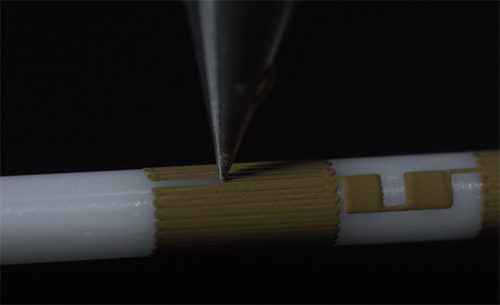Why Direct-Write Printing Should Be on Every Engineer’s Radar
A Primer on the Expanding Role of Printed Electronics in Modern Design
Rethinking Functional Integration
Across industries, engineers are under pressure to deliver unique solutions to designs, without compromising performance or reliability. Traditional approaches to integrating sensors, resistors, antennas, and heating elements often rely on discrete components and complex assemblies, introducing challenges around size, weight, manufacturability, and long-term durability.
Enter direct-write printing. This lesser known but increasingly vital process offers an alternative path, one that sidesteps many of the constraints of using discrete components in circuit design.
What Is Direct-Write Printing?
 Direct-write printing, sometimes called capillary dispensing, is a method of depositing conductive, resistive, or dielectric inks directly onto a substrate. Unlike lithographic or subtractive processes, it’s additive by nature. Materials are placed only where needed eliminating excess material, extra process steps and reduce cycle time
Direct-write printing, sometimes called capillary dispensing, is a method of depositing conductive, resistive, or dielectric inks directly onto a substrate. Unlike lithographic or subtractive processes, it’s additive by nature. Materials are placed only where needed eliminating excess material, extra process steps and reduce cycle time
This makes it especially well-suited for building electronic features directly into irregular or 3D geometries. Engineers can now add functionality to the surface of a substrate enabling circuit design in areas of a product originally considered prohibitive.
Why It’s Worth Your Attention
- Design Without Geometry Constraints
Direct-write printing allows you to add electronic functionality on surfaces that aren’t flat. Surface can be curved, flexible, even inflatable. For example, catheter balloons can be printed with radiopaque or electrode patterns that retain function during inflation, a feat that’s difficult to replicate with swaged components or embedded wires. - Less Hardware, More Integration
With direct-write, you can eliminate the need for certain interconnects, wires, and discrete components. That reduces not only weight and volume but also potential points of failure. This is a critical factor in aerospace, medical, and defense applications. - Faster Iteration and Customization
Because the process is digitally driven, it supports rapid prototyping and quick design changes. Engineers can explore more design variants in less time, tailoring ink formulations and deposition patterns to meet specific electrical or mechanical requirements.
Applications at the Forefront
 Medical Devices: Direct-write enables electrode arrays, heaters, and radiopaque markers to be placed directly on catheter shafts, balloons, or implantable surfaces. This can improve function without compromising biocompatibility or form.
Medical Devices: Direct-write enables electrode arrays, heaters, and radiopaque markers to be placed directly on catheter shafts, balloons, or implantable surfaces. This can improve function without compromising biocompatibility or form.
- Defense Equipment: The increasing reliance on electronics in ordinance can be enhanced by direct write printing. Complex circuits can be designed while simultaneously reducing size and weight. Quickly.
- Aerospace & Industrial Sensors: Lightweight, printed circuits on three dimensional surfaces reduce payload weight and improve device longevity in extreme environments.
Not Just for Specialists
Though still underutilized, direct-write printing is accessible to most design teams today. Partnering with a direct-write provider like Micropen, who brings decades of application-specific experience, means engineers don’t need to be materials scientists to take advantage of the technology.
What makes the Micropen approach noteworthy is its ability to adapt to the substrate, not the other way around. Their six-axis printing systems use a vision-based alignment process to map CAD patterns precisely onto real-world geometries. This enables precise deposition even on organic or flexible forms. Strong expertise in material science allows Micropen to match printing materials with the appropriate substrates to ensure material compatibility and adhesion.
Questions Worth Asking in Your Next Design Review
- Can printed functionality simplify our design?
- Are we limited by the physical size or rigidity of traditional components?
- Would embedded, low-profile sensors improve the user experience or product’s reliability or functionality?
Final Thoughts
Direct-write printing isn’t just a novel fabrication method. It’s a design enabler and a game changer. It lets you integrate function fluidly into form, opening up new strategies for miniaturization, ruggedization, and product design. For engineers working in high-reliability or space-constrained domains, it’s a capability that deserves serious consideration. Not someday, but now.
For those exploring how to bring this into a specific application, Micropen’s team has the tools and experience to help you validate the fit, from rapid prototyping to production-scale builds.